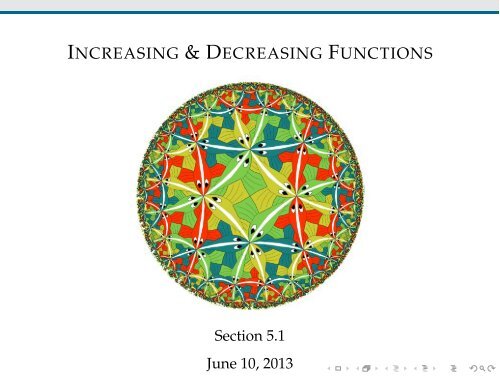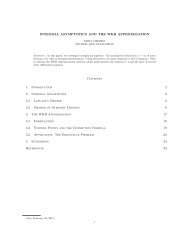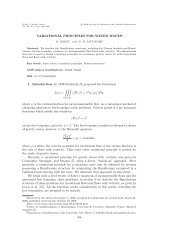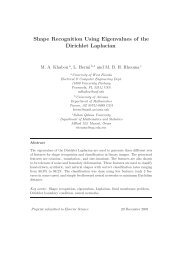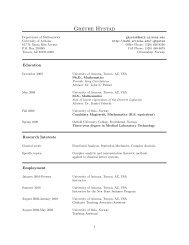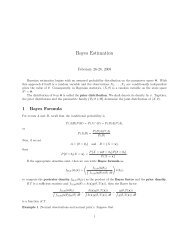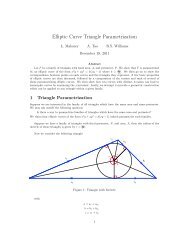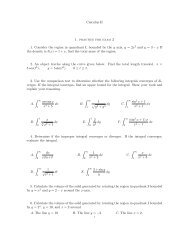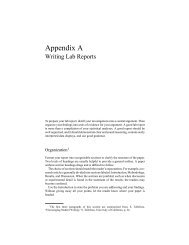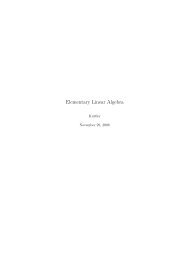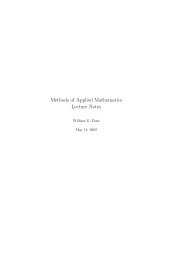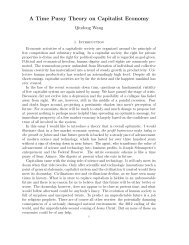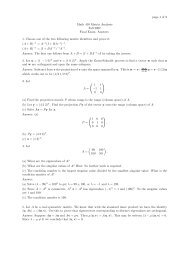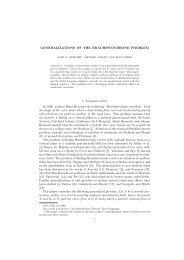INCREASING & DECREASING FUNCTIONS
INCREASING & DECREASING FUNCTIONS
INCREASING & DECREASING FUNCTIONS
You also want an ePaper? Increase the reach of your titles
YUMPU automatically turns print PDFs into web optimized ePapers that Google loves.
<strong>INCREASING</strong> &<strong>DECREASING</strong> <strong>FUNCTIONS</strong>Section 5.1June 10, 2013
<strong>INCREASING</strong> AND <strong>DECREASING</strong> <strong>FUNCTIONS</strong>f (x) = x 3 x 2 2x + 3.554321-1.5 -1 -0.5 0 0.5 1 1.5 2increasingWalking uphill means the function is increasing-1
<strong>INCREASING</strong> AND <strong>DECREASING</strong> <strong>FUNCTIONS</strong>f (x) = x 3 x 2 2x + 3.554321-1.5 -1 -0.5 0 0.5 1 1.5 2increasing-1decreasingWalking uphill means the function is increasingWalking downhill means the function is deceasing
<strong>INCREASING</strong> AND <strong>DECREASING</strong> <strong>FUNCTIONS</strong>f (x) = x 3 x 2 2x + 3.554321-1.5 -1 -0.5 0 0.5 1 1.5 2increasing decreasing increasingWalking uphill means the function is increasingWalking downhill means the function is deceasing-1
<strong>INCREASING</strong> AND <strong>DECREASING</strong> <strong>FUNCTIONS</strong>f (x) = x 3 x 2 2x + 3.554321-1.5 -1 -0.5 0 0.5 1 1.5 2increasing decreasing increasingWalking uphill means the function is increasingWalking downhill means the function is deceasingNeither increasing nor decreasing at a peak or valley.-1
<strong>INCREASING</strong> AND <strong>DECREASING</strong> <strong>FUNCTIONS</strong>Below is the graph of the function f (x).-10 -9 -8 -7 -6 -5 -4 -3 -2 -1 0 1 2 3 4 5 6 7 8 9 10-1Determine the interval(s) in which f (x) is increasing anddecreasing.increasing: ( 3, 0) [ (2, 1) decreasing:( 1, 3) [ (0, 2)654321-2-3-4-5-6
<strong>INCREASING</strong> AND <strong>DECREASING</strong> <strong>FUNCTIONS</strong>Consider the previous graph.54slope > 0321-1.5 -1 -0.5 0 0.5 1 1.5 2increasing decreasing increasing-1Tangent line has positive slope (f 0 (x) > 0) ) f is increasing.
<strong>INCREASING</strong> AND <strong>DECREASING</strong> <strong>FUNCTIONS</strong>Consider the previous graph.5slope = 04321-1.5 -1 -0.5 0 0.5 1 1.5 2increasing decreasing increasing-1Tangent line has positive slope (f 0 (x) > 0) ) f is increasing.Tangent line has slope of zero (f 0 (x) =0) ) f is neitherincreasing nor decreasing.
THE DERIVATIVE TESTConsider the previous graph.54slope < 0321-1.5 -1 -0.5 0 0.5 1 1.5 2increasing decreasing increasing-1Tangent line has positive slope (f 0 (x) > 0) ) f is increasing.Tangent line has slope of zero (f 0 (x) =0) ) f is neitherincreasing nor decreasing.Tangent line has negative slope (f 0 (x) < 0) ) f is decreasing.
<strong>INCREASING</strong> AND <strong>DECREASING</strong> <strong>FUNCTIONS</strong>Derivative Test for Increasing and DecreasingSuppose f (x) is a function whose derivative exists at everypoint in some interval (a, b).• if f 0 (x) > 0 for all x in (a, b), the function is increasing on (a, b).• if f 0 (x) < 0 for all x in (a, b), the function is decreasing on(a, b).• if f 0 (x) =0 for all x in (a, b), the function is constant on (a, b).How can we determine these intervals from the equation of thefunction?
<strong>INCREASING</strong> AND <strong>DECREASING</strong> <strong>FUNCTIONS</strong>If f 0 (x) goes from positive to negative (or vice verse) at the pointx = c in the domain of f , then one of two things must be true:(1) f 0 (c) =0, or(2) f 0 (x) does not exist at x = cWe call these x-values critical numbers.We can use the critical numbers of a function to determine theintervals over which it is increasing and decreasing.
<strong>INCREASING</strong> AND <strong>DECREASING</strong> <strong>FUNCTIONS</strong>Let f (x) =2.3 + 3x x 2 .Determine the open intervals where the f is inc./dec.Step 1: Find the critical numbers of fTo do this, we first find f 0 (x):f 0 (x) = 3Next, we determine for which x-values either f 0 (x) =0 or f 0 (x)is undefined.3 2x = 0 ) 3 = 2x ) x = 3 2f 0 (x) is a polynomial ) f 0 (x) is defined for all real numbersSince x = 3/2 is in the domain of f ,2xCritical number: x = 3 2
<strong>INCREASING</strong> AND <strong>DECREASING</strong> <strong>FUNCTIONS</strong>Let f (x) =2.3 + 3x x 2 .Determine the open intervals where the f is inc./dec.Step 2: Use the derivative testFrom Step 1 we know that we have a critical number at x = 3/2Our one critical number divides the domain of f (all realnumbers) into two intervals.0 1.5Choose one point a from the first interval and check if f 0 (a) > 0or f 0 (a) < 0.f 0 ( 1) = 3 2( 1) = 5 > 0So our original function f is increasing on the first intervalf is increasing on (-∞,1.5)-10 1.5
<strong>INCREASING</strong> AND <strong>DECREASING</strong> <strong>FUNCTIONS</strong>Let f (x) =2.3 + 3x x 2 .Determine the open intervals where the f is inc./dec.Step 2: Use the derivative testNext, choose a point in the second intervalf 0 (2) = 3 2(2) = 1 < 0So our original function f is decreasing on the first intervalf is decreasing on (1.5,∞)0 1.5 2Putting this all together:f is increasing: ( 1, 1.5) f is decreasing: (1.5, 1)
<strong>INCREASING</strong> AND <strong>DECREASING</strong> <strong>FUNCTIONS</strong>Determine the open intervals where the following functions areincreasing and decreasing(1) f (x) = 1 3 x3 + 1 2 x2 6x + 5(2) g(t) =t 2/3(3) h(y) = 3y + 6(4) P(r) = p r 2 1
<strong>INCREASING</strong> AND <strong>DECREASING</strong> <strong>FUNCTIONS</strong>A county realty group estimates that the number of housingstarts per year over the next three years will beH(r) =3001 + 0.03r 2where r is the mortgage rate (in percent):(a) Where is H(r) increasing?(b) Where is H(r) decreasing?


